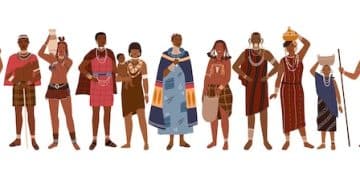Analyzing the Impact of Critical Race Theory on African American Literature in 2025

Analyzing the Impact of Critical Race Theory on the Interpretation of African American Literature in 2025 explores how CRT shapes literary analysis, focusing on themes of race, power, and social justice within the context of rapidly evolving social narratives.
The landscape of literary criticism is ever-changing, influenced by social, political, and cultural shifts. One prominent lens through which literature is increasingly examined is Critical Race Theory (CRT). In this article, we delve into analyzing the impact of Critical Race Theory on the interpretation of African American Literature in 2025, exploring its influence on understanding key themes and narratives.
As we navigate the complexities of present-day discourse on race and identity, examining how CRT informs our reading of African American literary works becomes even more critical. Join us as we unpack this intersection and consider its implications for future literary scholarship and understanding.
Unpacking Critical Race Theory: A Foundation
To fully understand its impact, it’s essential to first define Critical Race Theory. CRT emerged from legal studies in the 1970s and 1980s as a framework for examining how race and racism have shaped legal systems and societal norms. Its core tenets have since expanded to influence various fields, including literature.
Key Principles of CRT in Literary Analysis
Critical Race Theory provides several key principles that are useful when applied to literary analysis. These concepts allow for a more profound understanding of power dynamics within texts.
- Intersectionality: Recognizing the interconnected nature of social categorizations such as race, class, and gender, and how they create overlapping systems of discrimination or disadvantage.
- Whiteness as a Social Construct: Critically examining how “whiteness” is constructed and maintained as a dominant norm, often invisible and unquestioned, which impacts people of color.
- Voice of People of Color: Valuing the lived experiences and perspectives of people of color, recognizing that their voices are often marginalized or excluded from mainstream narratives.
These tenets play vital roles in analyzing the impact of Critical Race Theory on the Interpretation of African American Literature in 2025. By promoting inclusive literary evaluations, CRT enables us grasp the implications on social justice, equity and complex narratives.

The Historical Context of African American Literature
African American literature is deeply rooted in the history of the United States, reflecting the experiences of slavery, the Civil Rights Movement, and the ongoing struggle for racial equality. Understanding this historical backdrop is crucial when applying Critical Race Theory.
Common Themes in African American Literature
African American literature explores a range of themes that are often intricately tied to race and social justice. Recognizing these patterns is fundamental to analyzing the impact of Critical Race Theory on the Interpretation of African American Literature in 2025.
- The Burden of Slavery: Many works explore the physical, emotional, and psychological trauma caused by slavery and its lasting impact on individuals and communities.
- The Search for Identity: Characters often grapple with questions of identity in a society that marginalizes African Americans.
- Resistance and Resilience: African American literature showcases acts of resistance against oppression and the remarkable resilience of individuals facing adversity.
In 2025, these themes continue to resonate, offering insights into contemporary racial discussions and challenges.
Analyzing the Impact of Critical Race Theory on the Interpretation of African American Literature in 2025
In 2025, Critical Race Theory continues to significantly shape how African American literature is interpreted. Its emphasis on racial power dynamics provides deeper insights into historical and contemporary works.
How CRT Changes the Reading Experience
When applied correctly, Critical Race Theory enriches our understanding of literary texts, uncovering layers of context that might otherwise be missed.
- Challenging Dominant Narratives: CRT encourages readers to question prevailing perspectives and assumptions, uncovering hidden biases within texts.
- Amplifying Marginalized Voices: CRT brings attention to the experiences and perspectives of marginalized characters, offering a more inclusive interpretation.
- Examining Systemic Racism: CRT moves beyond individual acts of prejudice and explores how racism is embedded within institutions and cultural norms.
By analyzing the impact of Critical Race Theory on the Interpretation of African American Literature in 2025, we can gain crucial perspectives on race, power, and social justice narratives.

Potential Criticisms and Limitations of CRT
While CRT offers valuable insights, it is also subject to criticism. Understanding these critiques is important for a balanced perspective.
Common Criticisms
It’s vital to recognize the possible limitations while analyzing the impact of Critical Race Theory on the Interpretation of African American Literature in 2025. Criticisms from different angles enable a deeper and richer understanding.
- Overemphasis on Race: Some critics argue that CRT places excessive emphasis on race, potentially overlooking other factors that influence human experiences.
- Divisiveness: Others suggest that CRT can be divisive, creating tension and animosity between different racial groups.
- Lack of Objectivity: Some critics worry that CRT’s focus on social justice may lead to subjective interpretations that disregard objective literary analysis.
These criticisms highlight the importance of applying CRT thoughtfully and critically, considering alternative perspectives and avoiding simplistic conclusions.
Case Studies: CRT in Action
Examining specific literary works through the lens of Critical Race Theory can demonstrate its practical application. Let’s explore a couple of hypothetical case studies to illustrate this.
Hypothetical Case 1: “The Souls of Black Folk” by W.E.B. Du Bois
Applying CRT to Du Bois’s classic can reveal how the concept of “double consciousness” reflects the psychological impact of systemic racism. Analyzing the text through a CRT lens in 2025 might focus on how these themes resonate with contemporary discussions about identity and belonging.
Hypothetical Case 2: “The Color Purple” by Alice Walker
CRT can shed light on how Walker’s novel critiques patriarchal structures within the African American community and explores the intersections of race, gender, and class. In this case, analyzing the impact of Critical Race Theory on the Interpretation of African American Literature in 2025 can draw on historical perspectives and contemporary narrative views.
These examples underscore the potential of CRT to unlock deeper understandings of African American literature, revealing complex themes and social critiques.
The Future of CRT in Literary Studies
Looking ahead to 2025 and beyond, Critical Race Theory is likely to remain a significant force in literary studies, continuing to shape interpretations and scholarly debates.
Evolving Applications of CRT
- Interdisciplinary Approaches: CRT is likely to be integrated with other theoretical frameworks, such as postcolonial theory and queer theory, to provide more nuanced analyses.
- Digital Humanities: The use of digital tools and platforms may facilitate the application of CRT, allowing for new forms of textual analysis and collaborative research.
- Global Perspectives: CRT may be used to examine African American literature in a global context, exploring its connections to diasporic experiences and transnational movements.
As these trends unfold, analyzing the impact of Critical Race Theory on the Interpretation of African American Literature in 2025 and beyond becomes vital for scholarly work and understanding social issues.
| Key Point | Brief Description |
|---|---|
| 💡 CRT Definition | Examines race and racism in legal systems. |
| 📚 Themes in Lit | Slavery, identity, resistance are core themes. |
| 🔎 CRT’s Impact | Challenges biases and amplifies voices. |
| 🚀 Future of CRT | Interdisciplinary and globally applied. |
Frequently Asked Questions
Critical Race Theory examines how race and racism shape legal systems and societal norms. In literature, it explores racial power dynamics within literary texts, offering deeper insights into marginalized voices.
Common criticisms include that it overemphasizes race, may be divisive, and lacks objectivity. It’s important to thoughtfully apply CRT, considering alternative perspectives to avoid simplistic conclusions.
It will likely lead to more interdisciplinary approaches, integration with digital humanities, and broader global perspectives. This allows for nuanced analyses of race and social justice narratives.
Yes, CRT can be applied to various forms of literature, including works from different cultural backgrounds and genres. This can expose insights into power and social dynamics.
Intersectionality recognizes the interconnected nature of race, class, and gender, allowing for an understanding of overlapping systems of discrimination and uncovering biases that might affect literary analysis.
Conclusion
Analyzing the impact of Critical Race Theory on the Interpretation of African American Literature in 2025 reveals its significant role in shaping literary discussion and scholarly debates. Understanding CRT’s key principles, potential criticisms, and evolving applications are crucial while navigating its complex and impactful influence.
As we look to the future, Critical Race Theory will likely be a driving force in literary studies, informing how we interpret and discuss the critical aspects of culture, society, and identity.





